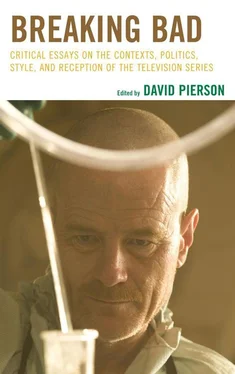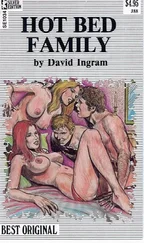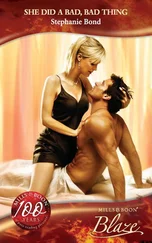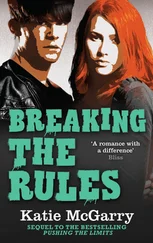David Pierson - Breaking Bad
Здесь есть возможность читать онлайн «David Pierson - Breaking Bad» весь текст электронной книги совершенно бесплатно (целиком полную версию без сокращений). В некоторых случаях можно слушать аудио, скачать через торрент в формате fb2 и присутствует краткое содержание. Город: Lanham, Год выпуска: 2014, ISBN: 2014, Издательство: Lexington Books, Жанр: Критика, на английском языке. Описание произведения, (предисловие) а так же отзывы посетителей доступны на портале библиотеки ЛибКат.
- Название:Breaking Bad
- Автор:
- Издательство:Lexington Books
- Жанр:
- Год:2014
- Город:Lanham
- ISBN:978-0-7391-7924-6
- Рейтинг книги:4.5 / 5. Голосов: 2
-
Избранное:Добавить в избранное
- Отзывы:
-
Ваша оценка:
- 100
- 1
- 2
- 3
- 4
- 5
Breaking Bad: краткое содержание, описание и аннотация
Предлагаем к чтению аннотацию, описание, краткое содержание или предисловие (зависит от того, что написал сам автор книги «Breaking Bad»). Если вы не нашли необходимую информацию о книге — напишите в комментариях, мы постараемся отыскать её.
Breaking Bad
Section two investigates how the series characterizes and intersects with current cultural politics, such as male angst and the re-emergence of hegemonic masculinity, the complex portrayal of Latinos, and the depiction of physical and mental impairment and disability.
The final section takes a close look at the series’ distinctive visual, aural, and narrative stylistics. Under examination are
’s unique visual style whereby image dominates sound, the distinct role and use of beginning teaser segments to disorient and enlighten audiences, the representation of geographic space and place, the position of narrative songs to complicate viewer identification, and the integral part that emotions play as a form of dramatic action in the series.
Breaking Bad — читать онлайн бесплатно полную книгу (весь текст) целиком
Ниже представлен текст книги, разбитый по страницам. Система сохранения места последней прочитанной страницы, позволяет с удобством читать онлайн бесплатно книгу «Breaking Bad», без необходимости каждый раз заново искать на чём Вы остановились. Поставьте закладку, и сможете в любой момент перейти на страницу, на которой закончили чтение.
Интервал:
Закладка:
Despite popular and critical success, by the debut of the fifth and final season in July 2012, there had yet to be a major collection of cultural criticism examining the series in real depth. [2] The only full-length work of criticism thus far published is Breaking Bad and Philosophy: Badder Living Through Chemistry , edited by David R. Koepsell and Robert Arp. Although it contains some interesting essays, this collection is part of the “Popular Culture and Philosophy” series that often trades in-depth analysis for speed in hitting the marketplace quickly after a film or television series’ success.
There are, however, a number of essays and books exploring the representation of Latinos in film and television, particularly by academics since the 1980s. These academics focused upon the manner in which mainstream artistic expression evidenced a fascination with the cultural ‘Other,’ and focused upon how the patterns or portrayal that evolved evidenced certain cultural fears or attitudes. Ever since Thomas Edison’s 1894 kinetograph short Chinese Opium Den , film has provided a rich medium for an audience’s fascination with the Other. Due to American manifest destiny serving as the controlling metaphor for the spread of the European colonizer across the North American continent, [3] It is interesting to note that the American frontier was declared closed by Frederick Jackson Turner in 1893, right in the middle of the two moments often given for the beginning of cinema: Thomas Edison’s invention of the kinetoscope in 1891, and the Lumiere Brothers’ invention of the cinematographe in 1895. In other words, Americans were beginning to reflect upon the frontier and its contributions to the formation of the national character at a moment when new technologies allowed for visual and thus highly powerful visions of the past, many of which would quickly become rooted in notions of racial superiority.
notions of “the west” provided a narrative obsession throughout much of the twentieth century. It was only after the terrible losses sustained during Vietnam, both military and political in nature, that the western genre as a celebration to nation-building began to lose its appeal for American audiences. Ironically, it was during this moment that the political outgrowth of the American Civil Rights Movement began to seep into both the arts and academia, resulting in critics such as Chon Noriega who began to write powerfully and effectively about depictions of Latinos. Such critics noted the stereotypes that were rampant in American cinema and television, from the The Treasure of Sierra Madre (1948) and the image of the uncouth bandito (“We don’t need no badges!”) to the fiery, hyper-sexualized spitfire, made famous by Hollywood’s typecasting of Lupe Velez in the 1930s. As Stephanie Larson (2006) notes, despite existing in more politically enlightened times the representation of Latino males in contemporary television is no less troubling, as criminal elements are often invested in such characters: “Villainous representations of Hispanic men include sexually threatening males, criminals, gang members, drug dealers, and illegal aliens.” (58). José E. Limón (1992) cites the stereotypically aggressive and vicious qualities that contribute to the above depictions, but also notes that the Latino “also often appears as cowardly, apathetic, and dormant” (3).
One of the key reasons behind such crass stereotyping involves the dominant culture’s perceptions of the threat posed by a large and, following the Civil Rights Movement, increasingly energized minority. As Clara E. Rodriguez (1997) notes:
Hollywood’s history with each group has also been in part a reflection of larger political and economic relationships between the United States and other countries. Political and economic factors have clearly influenced how groups came to occupy or leave the position of negativized “Other” in the media… changes in the images of Latinos resulting from changing political conditions, geopolitical considerations, market factors, and protests from Latin America. (8)
Although in this passage Rodriguez discusses how the United States’ relationship with Mexico and other Latin American nations impacts representation in American film and television, clearly domestic events/movements such as the Zoot Suit riots of 1943, the United Farm Workers of America strikes of the 1960s, California’s Proposition 187 in 1994, and ongoing construction of the U.S.-Mexico Border Fence affect media portrayals of Latinos. Among other critics, Chon Noriega and Rosa Linda Fregoso have noted that stereotypes must be met with opposition in all aspects of the filmmaking process. As Fregoso (1993) notes, “the project of Chicano cinema may succinctly be summed up as the documentation of social reality through oppositional forms of knowledge about Chicanos” (xv). During a time of complex empowerment for Latin Americans living in the United States, where citizens wield greater economic and political power than ever before but illegal immigrants continue to struggle, Breaking Bad and other forms of popular media are reflecting the complex times in which we live. In so doing, the series undermines many of the stereotypes that have long been perpetuated in American film and television, although there are a few negative associations that are affirmed.
Breaking Bad is a narrative about the drug business, and despite the fact that the two primary characters—Walter White (Bryan Cranston) and Jesse Pinkman [4] Even the names of these two characters—White and Pinkman (pink + man)—perform their Anglo-ness, and at no time during the narrative are either of them imbued with any of the stereotypical traits or qualities associated with Latinos. The only moment White is portrayed as a Latino figure is when Heisenberg appears as a character in a narcocorrido at the beginning of “Negro Y Azul” (4/19/09). Narcocorridos are Mexican folk ballads that portray border culture and are generally favorable toward drug smuggling and other criminal activity.
(Aaron Paul)—are Anglo drug manufacturers, there is no shortage of Latino characters in this series’ depiction of the industry. Some of these Latino characters operate north of the border, some south of the border. A character who represents the fluidity of the U.S.-Mexico border is Tuco Salamanca (Raymond Cruz), a character who lives in New Mexico but has ties to the Mexican drug cartel. [5] Due to the continually shifting nature of cartel alliances during the Mexican Drug War (2006 to the present), as well as the fact that Breaking Bad avoids giving specifics as to which cartel Don Eladio controls, it is difficult to know to whom Tuco owes his allegiance. Theoretically, due to the narrative’s setting in Albuquerque, which although 250 miles to the north of El Paso is still part of the border drug zone and a shipping hub to various parts of the American Southwest, the cartel referenced is most likely either the powerful Sinaloa cartel, which controls much of the western part of Mexico, or the Juarez cartel, which controls much of the area immediately surrounding Ciudad Juarez/El Paso. According to Héctor Dominquez-Ruvalcaba and Igancio Corona (2010), this part of northern Mexico constitutes the biggest drug corridor in the world, with three of the five largest Mexican cartels vying for control of delivery and distribution to the North American drug market (3). Certainly, the areas in the series portrayed south of the border, including the land around Don Eladio’s villa, appear to be a good match for the Chihuahuan Desert of north-central Mexico. The appearance of the Salamanca cousins in season three, however, complicates this hypothesis. The body shop worker being smuggled across the border, who worked for “some of the biggest gangsters in Michoacán,” recognizes the shoes worn by the hit men, suggesting that they at one point worked for either the La Familia Michoacán group or the Knights Templar cartel. So, there is no way of knowing for sure to which cartel Eladio or any of the Salamancas belong, and it is certainly possible due to the shifting alliances that multiple cartels are involved in the narrative. For a wealth of information about the Mexican Drug War, see the Los Angeles Times website “Mexico Under Siege” (2012), a clearing house of articles, photographs, and videos from over a four year period.
One of the first major Latino figures to enter the narrative, Tuco fits pre-existing stereotypes of Latin American drug dealers. He is violent, paranoid, and perhaps even psychopathic; furthermore, he is given to wild outbursts, both oratorical and physical in nature, and appears constantly on the edge of giving over to his base emotions. The first time Pinkman meets him in “A Crazy Handful of Nothin” (3/2/08), Tuco compliments the methamphetamine he is given by saying that it “kicks like a mule with his balls wrapped in duct tape,” but then proceeds to physically assault Pinkman when the latter asks for payment. Tuco’s actions when White arrives to demand payment are no less volatile—he puts a cigarette out on his own tongue and threatens to rob him as well—although he does come to admire White after the former demonstrates his strength by nearly blowing up the building with fulminated mercury. In the cliffhanger to season one, “A No-Rough-Stuff-Type Deal” (3/9/08), Tuco beats one of his own henchmen to death because the man speaks out of turn. In this scene, he is reminiscent of Joe Pesci’s characters in both GoodFellas and Casino . His propensity toward violence is definitely linked to his emotional volatility, but it does serve the purpose of sending a message to those with whom he does business. Indeed, as he beats his employee senseless, a look of shock but also awareness appears on the faces of both White and Pinkman, who finally realize the bind in which they now find themselves: they have thrown in with and now work for a maniac. Tuco’s violent outbursts are fueled by his addiction to the product he sells. He thus fits into a tradition of cinematic drug dealers whose downfall comes when they allow their addictive personalties to overwhelm reason and dominate their lives. Although there are some well known examples that involve Anglo characters (notably George Jung in Blow (2001), which is based on a true story), the prototype for this trope comes from Brian De Palma’s Scarface (1983), [6] It should be noted that although the figure of the over-the-top Latino drug kingpin became entrenched in the popular media after the rise of the Columbian cartels, links between Latin America and drug culture preceded Scarface by decades. The Opium Exclusion Act of 1909 made that drug illegal, leading to addicts looking for other avenues for a fix. Marijuana proved to be inexpensive and easy to obtain, leading to a growing concern over its hold over young people during the inter-war period and culminating with highly sensationalized “educational” films such as Reefer Madness (1936) and Assassin of Youth (1937). However, it wasn’t until Raymond Chandler and the Beat poets during and immediately after World War II that this association was made more firmly in popular culture. Set in the criminal underbelly of Los Angeles, Chandler’s short stories and novels often involved drug plots, and one section of Jack Kerouac’s On the Road (written in 1951, published in 1957) depicts the ease in which marijuana can be obtained in a Texas border town. As they were subject to a censoring body, mainstream films were a bit slower than novels to explore this terrain, although certainly one of the directors who began to push the boundaries on this subject, Orson Welles, made the connection between drugs and Latin America in Touch of Evil (1958). By the late 1960s with films such as Easy Rider (1969), the link was firmly established, although the character of the kingpin did not become solidified in popular culture until later.
which updates Howard Hawks 1932 original by moving the narrative to Miami and centering the story upon Cuban immigration and cocaine. Although he is Italian-American, Al Pacino’s portrayal of Tony Montana solidified the cinematic stereotype of the wild-eyed, unstable Latin American drug dealer addicted to his own product. Tuco Salamanca is most definitely a cultural inheritor of that fairly young albeit nonetheless powerful stereotype.
Интервал:
Закладка:
Похожие книги на «Breaking Bad»
Представляем Вашему вниманию похожие книги на «Breaking Bad» списком для выбора. Мы отобрали схожую по названию и смыслу литературу в надежде предоставить читателям больше вариантов отыскать новые, интересные, ещё непрочитанные произведения.
Обсуждение, отзывы о книге «Breaking Bad» и просто собственные мнения читателей. Оставьте ваши комментарии, напишите, что Вы думаете о произведении, его смысле или главных героях. Укажите что конкретно понравилось, а что нет, и почему Вы так считаете.












